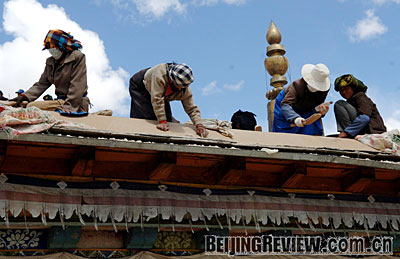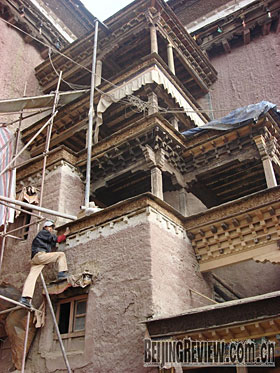|
The Southern Monastery was used as an office for the Sakya County Government. At that time, the county was extremely poor, but its monastery was the most beautiful building in the area.
 |
|
SKILLED HANDS: Local workers are hired to help restore Sakya Monastery (XINHUA) |
"During the 'cultural revolution,' the monastery was considered an evil place. But today, it is treasured as one of the most priceless cultural relics in China," Tsering said.
After China adopted its reform and opening up policy in 1978, the Southern Monastery reopened to visitors and pilgrims in 1979. Since then, the Central Government has poured money into the restorative process.
Local residents and monks who bravely gathered valuable artifacts and sutras to store at home for fear of having them destroyed during the "cultural revolution," have since returned many of these to the monastery.
"The local residents and monks of the monastery played a vital role in protecting the vast volumes of sutras," said Tsering. He said because of their bravery and contribution, Sakya Monastery now houses the biggest number of Tibetan Buddhist cultural relics of all the monasteries in China.
Grand restoration
While Sakya Monastery has undergone several repairs in history, the investment in the 21st century restoration project is by far the biggest.
The geographic location of Sakya Monastery, 4,300 km above sea level, posed a challenging test for all workers engaged in the project.
Limited oxygen (about 60 percent of that in the interior) and extremely dry weather especially in winter makes the work tough going.
"The duration time of repair work each year is very short: starting from May to September. During the rest of the year, we usually reinforce the wooden structures and transport materials," said Tsering.
 |
|
TOUGH TASK: A craftsman perches high up on the walls of the Sakya Monastery as it nears restoration completion (XINHUA) |
In practice, the repair team sets up an isolation belt to separate tour sites from restoration sites. The system seems to work as the monastery monks say they haven't received any complaints from pilgrims.
The mural restoration is the most difficult part of the work, and involves the biggest investment of all three projects. The total area of murals covers over 2,000 square meters, and some of them are unrecognizable after 800 years of existence.
The murals require specific temperature and humidity levels for the paint to adhere the walls and the work can only be done by hand. Locals skilled in mural art are used.
"In repair, we strictly stick to national cultural relic maintenance principles: maintaining the original size, shape, color, material and techniques," said Tsering.
However, the team had encountered intense disagreement on how the monastery should be restored.
Local people, as well as the monks, believe the monastery must be completely rebuilt from scratch. Some doubt that 100 million yuan ($14.6 million) has been allocated for repair, saying in many places they can see no changes.
"They want everything looking sparkling, like modern architecture," said Tsering. He spent much of his time explaining the necessity of preserving the monastery as it was in ancient times.
Persistence and patience have paid off and Tsering eventually convinced the monks that the purpose of restoration was to return the Monastery to its original state, not create a modern replica of itself.
The monastery now houses a museum, a warehouse and a showroom of cultural relics made up of more than 5,400 Buddhist statues.
To date, the surrounding walls, turrets, watchtowers, living quarters and cultural relic warehouse have been finished and are in use. Still to be completed by September is the installation of safety control, a fire-fighting system, lighting, drainage and lightning protection system.
"In September when everything is finished, we welcome people from across the world to participate in the grand completion ceremony held in Sakya County, Shigatse," said Wu Yingjie, Executive Vice Governor of Tibet Autonomous Region.
Sakya today
After the repair work began in 2002, an increasing number of visitors and pilgrims make the journey to Sakya to marvel at its resurrection.
| 